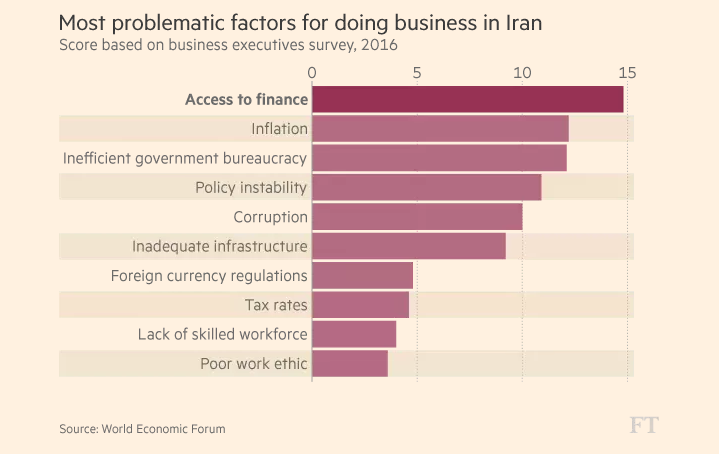Iran voted on Friday in an election, the result of which will decide the direction of an economy still recovering from years of crippling sanctions—a state of affairs revealed in the charts below, reads a Financial Times article. Below is the full text:
Overall, the country has rebounded impressively since an international deal was struck in 2015 to restrict its nuclear program in return for an easing of sanctions. Under reformist president Hassan Rouhani, Tehran successfully contained rocketing inflation, stabilized its currency and returned the economy to growth.
But Iran is still grappling with high and rising unemployment and a weak banking system.
And, in its latest report on the country, the International Monetary Fund says it is “still some distance away from fully tapping its huge investment and trade potential, given its vast hydrocarbon reserves, relatively diversified non-oil sector, large domestic market and young and well-educated labor force”.
Return to Oil
Since sanctions were lifted, Tehran has ramped up oil output to return to well above pre-sanction levels. Crude exports in March briefly touched a level not seen since the Islamic Revolution in 1979.
In particular, Iran has benefited from an exemption from an OPEC deal agreed in November that restricted output in other major oil-producing countries. The Islamic Republic had argued that it was still recovering from sanctions.
The production levels could continue to rise: Iran ranks fourth and second, respectively, in the world in terms of proven oil and gas reserves.
Economy Rebounds
Sanctions hit the economy hard in 2012. But their lifting and Rouhani’s reform agenda have helped stabilize the economy. In 2016, it grew 6.6%, driven by a record 52.2% pickup in oil-related output, according to the IMF.
The fund’s outlook suggests a stable but more muted recovery, supported by higher oil prices and closer integration with the global economy. Annual GDP growth is forecast to be 3-5% for the next five years.
Inflation Curbed, Currency Stabilized
When Rouhani became president in 2013, the economy was in recession and inflation was hovering at about 40%. His government made taming inflation a priority. Although inflation has crept up slightly this year, largely because of rising food prices, it has remained below 10% since the end of 2016.
The exchange rate also stabilized, but the rial weakened at the end of last year, caused in part by concerns that the incoming Trump administration would take a more hostile stance toward Iran, according to Andrea Rutherford, an analyst with Rutherford Frontiers.
Foreign investment
Lower inflation and a stabilization of the currency, together with the government’s pro-business policies, have helped Iran attract more foreign investment.
According to data from fDI markets, greenfield investments exceeded $12 billion last year, about five times the average annual amount in the seven years to 2010.
The trend has continued in 2017, with five new projects worth $1.3 billion launched in the first three months.
But investments have been highly concentrated: Nearly 70% of the money invested since 2016 have been in the oil sector, with the rest largely split among metals, alternative forms of energy and the rapidly growing automotive sector.
While the money is helping rebuild aging oil infrastructure, it has had a limited impact on the non-oil economy. Oil still accounts for about 75% of the value of goods exports.
Access to Finance
Sanctions forced Iran to diversify its economy away from oil, toward manufacturing and construction, for example. However, efforts to develop these sectors have stretched the banking system, which remains fragile.
Iranian banks were instructed to allocate at least 10% of their loans to small- and medium-sized enterprises and manufacturing companies.
In turn, those “discretionary loans led to a massive jump in [the amount of] non-performing loans,” says Richard Torne, the head of economic research on Iran at Focus Economics.
The strain on the financial sector has been made worse by the sanctions and economic crisis, and the IMF has warned that “banks should be restructured and recapitalized … to reduce high lending rates and support growth”.
Iran’s executives complain that lack of access to finance is their most pressing problem, according to the Global Competitiveness survey.
Unemployment
With the non-oil sector not yet fully developed, Iran struggles to find jobs for its booming population and high unemployment has persisted.
More than one in 10 people is unemployed, a proportion that has risen over the past couple of years despite the return to growth.
The population is young—under-25s account for about 40% compared with 28% in high-income countries—and increasingly well educated. But the youth unemployment rate stands at 27% and is more than 44% among young women.


